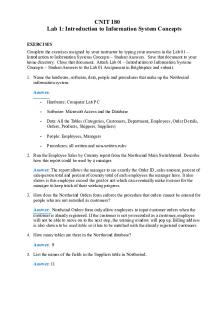Lab hemocytometer - Intro to Lab Theory and Technique- Lisa Deucunick PDF

| Title | Lab hemocytometer - Intro to Lab Theory and Technique- Lisa Deucunick |
|---|---|
| Course | Intro Lab Theory & Techniques |
| Institution | Oakland University |
| Pages | 2 |
| File Size | 74 KB |
| File Type | |
| Total Downloads | 52 |
| Total Views | 124 |
Summary
Intro to Lab Theory and Technique- Lisa Deucunick ...
Description
Hemocytometer Principle: To become familiar with the use of hemocytometers, to interpret data collected from hemocytometers, and to practice principles of microscopy. Background: A hemocytometer is a specialized microscope slide that allows for counting of cells or objects in a sample. Familiarity with use and interpretation of hemocytometers is essential to accurately collect data. A hemocytometer contains an etched glass counting chamber for enumerating the number of cells or objects in a suspension. The chamber holds a specific volume of liquid and has grid lines etched into the glass so that cells can easily be counted using a microscope. Equipment: 1. Hemocytometer and cover-slip 2. Cell suspensions 3. Tally Counter 4. Capillary tubes 5. Microscope 6. Lens paper 7. Lens cleaner Procedure: 1. Collect a hemocytometer (hemocytometers are expensive; please handle it carefully) and a capillary tube. 2. Carefully clean the hemocytometer and coverslip with lens paper and lens cleaner. Place the coverslip over the counter chambers of the hemocytometer. 3. Fill the capillary tube with the 1/100 cell suspension. 4. Load one side of the hemocytometer by touching the end of the capillary tube to the “V” of the hemocytometer. Touch just beneath the coverslip to allow the cell suspension to fill the chamber. Take care not to overfill the chamber. 5. Observe your sample at 4X magnification and familiarize yourself with the pattern of grid lines (Lowering the condenser will increase contrast if you have trouble seeing the grid lines). Find the central 25 square counting area. 6. Increase to 10X and familiarize yourself with the pattern and then increase to 40X magnification. 7. Count the number of cells in the four corners and central square of the counting region and record the number of cells counted below.
8. Calculate the concentration of your cells in the 1/100 cell suspension (cells/uL). Show your calculations.
9. Remove the hemocytometer from the microscope stage. 10. Load the empty chamber using the 1/10 cell suspension. Follow steps 3-7 and record the number of cells counted below.
11. Calculate the concentration of your cells in the 1/10 cell suspension (cells/uL). Show your calculations.
12. When you are done, clean your hemocytometer and return it to the front of the room.
Questions: A total volume of 1 mL of cell suspension was used for this exercise. The cells were diluted using saline.
1. How was 1/10 cell suspension made? What pipettes were used for each volume (style and range)?
2. How was 1/100 cell suspension made? What pipettes were used for each volume (style and range)?
3. What is the difference between the 1/10 and 1/100 cell suspension (how many more times cells are there in the 1/10 and 1/100 cell suspension)? Do the cells counts that you determined above make sense? Why?...
Similar Free PDFs

Lab 1 Intro to Science- eScience Lab
- 13 Pages

Lab Report Intro to Graphing
- 8 Pages

Lab 01- intro to system
- 2 Pages

Lab 1 - Intro to Measurement
- 10 Pages

BIO LAB Intro to Science
- 12 Pages

Intro To Media Theory Notes
- 29 Pages

Lab00 Intro - Lab assignment
- 4 Pages

Intro Spanish Sci Lab
- 63 Pages

Lab 8 Normalisation Theory
- 5 Pages
Popular Institutions
- Tinajero National High School - Annex
- Politeknik Caltex Riau
- Yokohama City University
- SGT University
- University of Al-Qadisiyah
- Divine Word College of Vigan
- Techniek College Rotterdam
- Universidade de Santiago
- Universiti Teknologi MARA Cawangan Johor Kampus Pasir Gudang
- Poltekkes Kemenkes Yogyakarta
- Baguio City National High School
- Colegio san marcos
- preparatoria uno
- Centro de Bachillerato Tecnológico Industrial y de Servicios No. 107
- Dalian Maritime University
- Quang Trung Secondary School
- Colegio Tecnológico en Informática
- Corporación Regional de Educación Superior
- Grupo CEDVA
- Dar Al Uloom University
- Centro de Estudios Preuniversitarios de la Universidad Nacional de Ingeniería
- 上智大学
- Aakash International School, Nuna Majara
- San Felipe Neri Catholic School
- Kang Chiao International School - New Taipei City
- Misamis Occidental National High School
- Institución Educativa Escuela Normal Juan Ladrilleros
- Kolehiyo ng Pantukan
- Batanes State College
- Instituto Continental
- Sekolah Menengah Kejuruan Kesehatan Kaltara (Tarakan)
- Colegio de La Inmaculada Concepcion - Cebu






